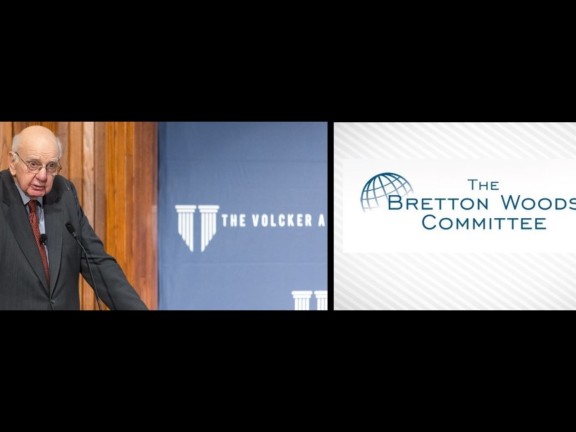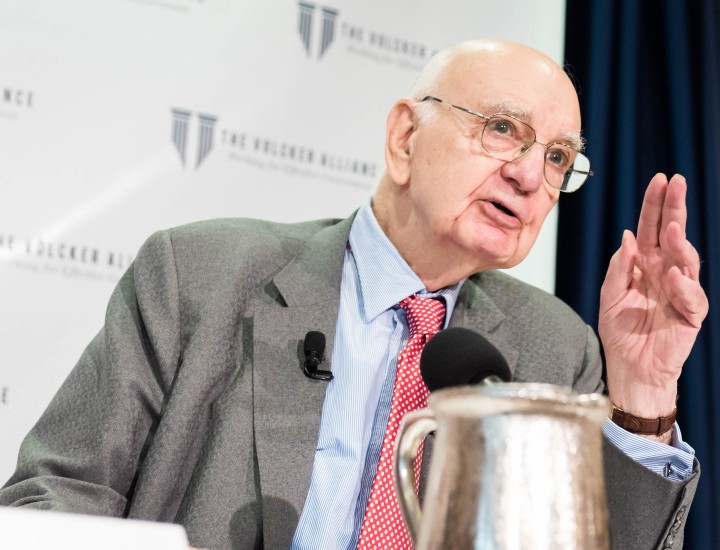The Future of the Global Financial System

The Bretton Woods Committee was formally established in 1983 out of deep-seated concerns that the international financial system was under great strain, with potentially adverse consequences for international cooperation. The role of the International Monetary Fund – established at Bretton Woods in 1944 as the guardian of a regime of fixed exchange rates – had come into question in a world of disorderly exchange rates. Its sister institution, the World Bank, found itself on the sidelines as massive flows of funds to the “less developed” world suddenly came to a halt, epitomized by the Latin American debt crisis of the early 80s.
In the midst of those strains, the founders of the Committee recognized that active American support of the “Bretton Woods” institutions – and more broadly of international financial cooperation – would be critical for maintaining a stable and open financial system in support of global growth and prosperity.
Here we are, more than a generation later. Major exchange rates are not fixed. Extreme fluctuations have at times continued to lead to distortions in trade and inflamed political relationships. Yet recurrent efforts, within and outside the Fund, to find greater stability have lacked support. And today, it is as much the United States that needs infrastructure investment as it is the old Bank clients which are now fully emerged or emerging and for the most part have adequate recourse to market borrowing.
For all of that, what remains relevant is the basic role of the Bretton Woods Committee – to foster understanding within the United States of the need for international financial cooperation, whether by means of the Fund and the Bank or other organizations.
After all, “Bretton Woods” is not a particular institution – it is an ideal, a symbol, of the never-ending need for sovereign nations to work together to support open markets in goods, in services, and in finance, all in the interest of a stable, growing, and peaceful world economy.
In some ways progress toward that end seemed easier – but of course not really easy – when the United States economy, its dollar, and its basic policy and political orientation were dominant. We can talk together about how the world has changed, and the difficulty of reaching a common approach, after I finish my few remarks. But I do want to take a few minutes to speak about the one area in which the need for big changes, national and international, was thrust upon us by the “great financial crisis” and its threat to the world economy.
My obvious point is that the depth and breadth of the crisis demanded a coordinated response. By and large, I think the international response – for all its fits and starts – has been reasonably successful. With the newly reformed and elevated G-20 providing political impetus and cover, substantial progress has been made – particularly in the Basle environment – to strengthen bank capital and liquidity requirements. Common ground among nations hosting the main financial markets is being found in addressing the complicated challenge of orderly resolution of failing banks operating across national boundaries. Efforts to recognize and reduce the risks of derivatives are receiving some attention, as is the need to encourage coordinated oversight of so-called shadow banking.
For all of that, I have a new concern. Perhaps inevitably after a few years of recovery, rising profits and the seeming restoration of financial stability, the presumed unshakeable commitment to sustaining reform appears to be waning. That may be most evident in the United States, but it’s true elsewhere as well.
A few years of greater stability should not mislead us. Relaxation of key reforms and the temptation to retreat inward into idiosyncratic domestic approaches needs to be resisted. Fragmented approaches toward what are inherently international markets and financial institutions would have costs in terms of fair competition, global market efficiency, and the ability to reach a concerted approach in the event of a serious future crisis. For instance, diverging regulatory approaches will lead to “ring fencing” banking operations within national borders. Coordination of emergency responses to orderly resolution of global firms would be impaired.
Here in the United States, the Dodd-Frank legislation laid out – at great length – a basically constructive approach for financial reform, regulation, and supervision. No doubt, the law and, even more, the subsequent regulations are highly detailed. After years of experience, a review of some of its provisions and practical effects is appropriate. But let me say at the outset that claims that Dodd-Frank and other regulatory approaches have somehow gravely damaged the effective functioning of American financial markets, the commercial banking system, and prospects for economic growth simply do not comport with the mass of the evidence before us.
Here we are in 2017 with a near fully employed economy, close to stable prices, bank profits at a new record, and the return on banking assets again exceeding one percent. Loans at both large and small banks are at new highs, double the pre-crisis years. In fact, loan growth has again been exceeding growth in nominal GDP. Long continued growth in debt faster than GDP would spell trouble. But today, non-performing loans are down close to the early 2000s and, prodded by the national and international regulators, capital ratios are higher than in many years. True, the returns on bank capital have not reached the pre-crisis exuberance, but that is not surprising in an era of exceptionally low interest rates.
That relatively happy story doesn’t negate the simple fact that review of some of the specifics of Dodd-Frank may be in order. For instance, reasonable questions have been pressed about the extent of the regulatory burden on community banks, institutions that play a critically important role in serving the needs of small businesses. It is also true that the basic role of community banks – channeling local “core” deposits into small business lending – is not systemically risky. And individually, true community banks are not likely to be “too big to fail”.
So recognition of those facts suggest relief could well be appropriate from the burdens and complexity of international capital standards, from the full panoply of stress testing, from the frequency of full-scale examinations, and from the complexity of call reports gauged necessary for the more complicated large institutions.
The challenge of course, is to define just what institutions are truly community banks. It’s not only a question of size. Trading activity, and certainly speculative financial positions, are not and should not be characteristic of a true community bank. Indeed, we should remain aware of aggressive risk taking in the form of community bank clothing!
Recently, I notice discussion has been renewed about the possibility of turning the regulatory approach back to prohibiting investment banking activity by all commercial banks – that is, to restore Glass-Steagall. That would raise much larger issues than a simple “tweaking” of Dodd-Frank and the so-called Volcker Rule. The questions go beyond the reorganization of the huge institutions at the heart of the modern financial system. I would point out that inconsistency with international practice would itself be a problem. Restoration of Glass-Steagall in any event must not enable large investment banks, to free themselves from regulation and supervision appropriate for a systemically important financial institution.
We must also be mindful that the combination of large banks and trading activities does give rise to chronic problems of conflicts of interest and potential degradation of customer relationships. As you know, back in 2009 when Congress was debating the proper response to the financial crisis, I made a seemingly modest and sensible suggestion to help ameliorate the problem. Banking institutions protected by the “Federal safety net” should be prohibited from taking “proprietary positions.” Specifically, they could maintain trading operations responding to customer initiatives, but should not deliberately speculate in markets for private securities or (within narrow limits) sponsor hedge or equity funds.
I was naïve enough to believe the basic concept and intent could be readily set out in the reform legislation with appropriate supervisory oversight. After much debate, the prohibition took up less than 10 pages in the Dodd-Frank Act. But, of course, agency interpretations of those 10 pages became grist for the lobbying mills that populate the “Washington swamp” and pressure the regulators as well as congressional and administrative officials.
Questions have been raised, some reasonable, some not, about clarifying the practical application of the concept. In the process, the regulators themselves, each with different priorities and financial industry relationships, haggled endlessly over the precise interpretation and enforcement of the legislative intent.
It took 5 years, but helped by aggressive urging of the then Secretary of the Treasury, the five directly affected regulatory agencies (the OCC, the SEC, the CFTC, the FDIC and the Fed) finally came to common (and very detailed) language on a final rule.
Meanwhile, my sense is that the large banks with sizable trading operations have been adjusting to the basic requirements. Proprietary trading units have been closed, equity and hedge funds have been sold or spun out, traders are subjected to appropriate constraints, and there has also been a clear tendency for the more aggressive traders to leave the government-protected banking organizations for relatively unregulated hedge funds or other firms. They are free to trade, to speculate, and to fail outside the official safety net.
Importantly, statistical evidence strongly supports the view that the market functioning with respect to bid-asked pricing, market stability, and so-called liquidity has not appreciably changed from pre-crisis performance. Data recently released by the Federal Reserve support these points. Put simply customers can be, and are, well served by today’s trading markets.
Two other issues, seemingly less pressing but of particular importance, definitely need attention. First, Dodd-Frank sets out a new approach for dealing with the imminent failure of large complex financial institutions. The procedures are designed to deal with the awkward and politically sensitive dilemma between “bailing out” failing big banks with “taxpayer money” on the one hand and refusing such assistance on the other hand, with the clear prospect of precipitating contagious “runs” and a huge damage to the economy.
The point of the proposed Dodd-Frank reforms is to deal with that dilemma. It would provide an approach for dealing with an imminent failure of a systemically large bank by means of a new resolution framework and an “orderly liquidation authority” (OLA). That framework explicitly sets out procedures by which the failing bank could in fact be reorganized and liquidated without precipitating infectious runs and a freezing of interrelated markets. Under the experienced auspices of the FDIC, managements would be removed, viable operations could be sold, stockholders and unsecured creditors would lose. In effect, there would be an orderly liquidation of the failed firm with breakup and sale of viable operational assets. In the process, some temporary advance of public funds to maintain continuity of operations may be required – but those funds would be secured by a prior claim on all the institutional assets and, if necessary, by fees imposed upon all systemic financial institutions.
Under the provisions of “OLA”, the failing institution will, by any reasonable definition of the word, have in fact failed – there is no “taxpayer bailout.” Rather it is the absence of the resolution framework that might inexorably lead some future government to rescue big failing financial institutions, just as happened in 2008.
Apparently that is not fully understood or felt to be credible by some in Congress. But what needs to be understood is that the existing approach has been developed in concert with other leading international regulatory authorities. This is an area where a common methodology is critically important internationally. After all, the banking institutions potentially involved invariably are themselves international in scope.
Finally, Dodd-Frank and the whole reorganization effort has left largely untouched the regulatory and supervisory arrangements in the United States. The historically fractured regulatory framework is riddled with gaping holes and overlaps. The inconsistencies in approaches among the half-dozen or more regulatory agencies stand as an enormous obstacle to achieving consistent and effective oversight of the financial system. It was this disjointed regulatory structure, among other public and private sector failings, that lulled regulators into a false sense of security before the crisis. And it deprived them of the understanding and tools necessary to address threats to systemic stability.
A wholesale redesign of the regulatory framework was not possible in the aftermath of the crisis. There were simply too many other competing legislative priorities. Instead, to facilitate agency coordination and help close regulatory gaps, Congress established the Financial Stability Oversight Council (“FSOC”) – a super-council of regulatory agency heads that is chaired by the Secretary of the Treasury with a mandate to identify and address the threats to financial stability.
While aimed at dealing with a very real concern of agency coordination and cooperation, the FSOC has itself become a matter of some controversy. It has made real progress in data gathering and analysis. But we need to recognize the FSOC is insufficient as a vehicle to overcome the serious flaws in the regulatory architecture. It cannot force competing agencies to take coordinated action. It cannot itself be the focus for cooperation with our international counterparts on systemic issues. It is simply not adequately equipped for the challenge of fairly and effectively supervising financial markets of the complexity, sophistication, and size characteristic of the 21st century.
I know of no matter of financial regulation in which there is so much common concern – among those regulated, those doing the regulation, and those who over the years have participated in reform efforts – than the fragmented structure of regulatory agencies. At the same time, there is enormous resistance to change. Turf is vigorously defended. Particular interests find advantage in institutional diversity.
I well understand that reform is a difficult political and administrative undertaking, challenging both the agencies and the Congress. My point here is to encourage the Congress and the new Administration to launch together a serious study of how to deal with the shortcomings of a system which has outlived its rationale and usefulness.
That is a project worthy of a new administration interested not only in tweaking of oversight and regulatory procedures, but rather in simplifying an archaic, unduly complicated regulatory system – a structure that is itself acting as an impediment to efficient and stable markets.
Given the nature of this occasion – “Bretton Woods” and all those two words evoke in terms of a grand vision of international cooperation and stable monetary systems – matters of domestic financial regulation may seem prosaic. But I hope we have learned the lesson that financial distress cannot be localized, that markets are inextricably interlinked.
In the event of a major future crisis, there is no possibility of an international “bailout” of the American financial system. So, we had better work to keep it strong.


